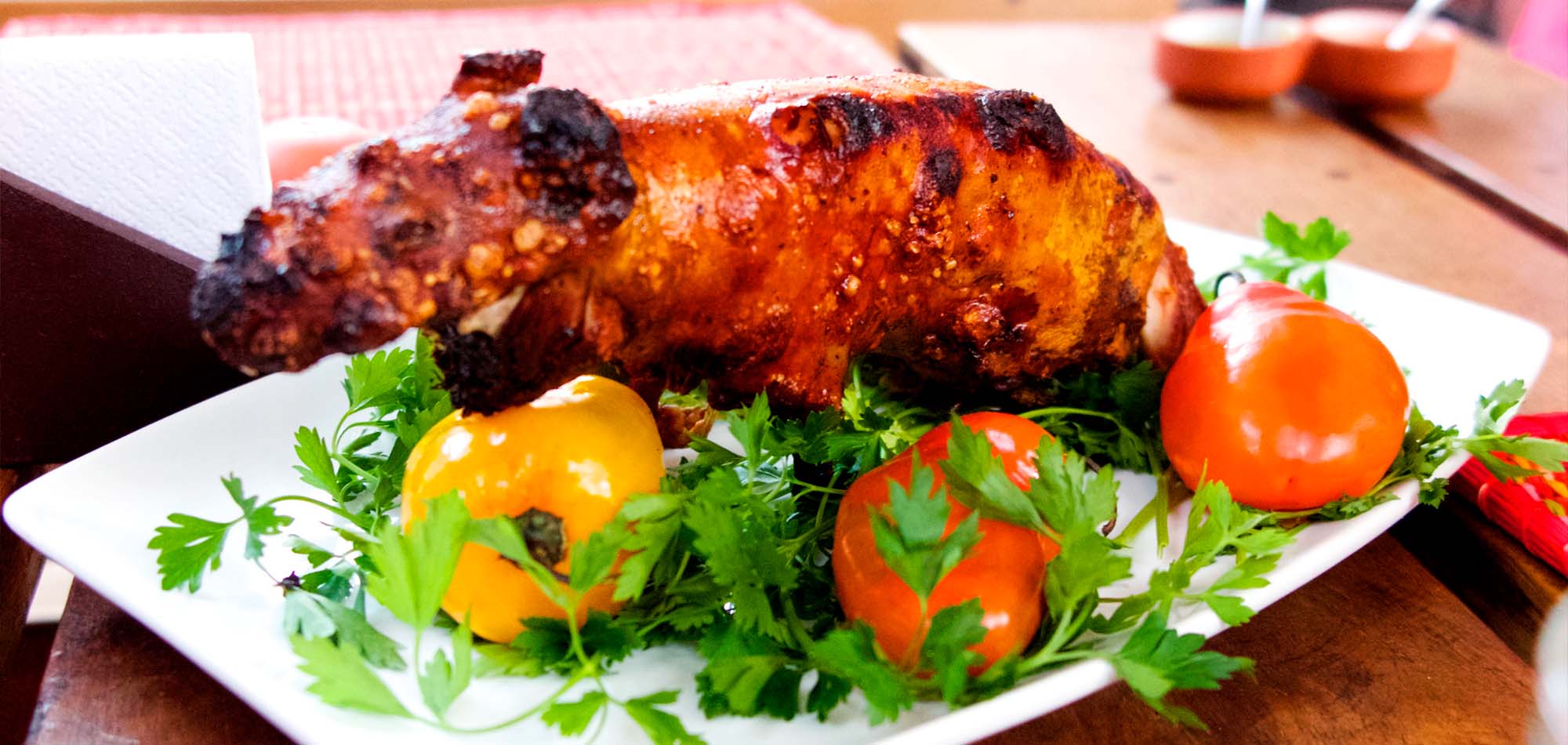
‘Cuy Guinea Pig’ unique and flavorful delicacy, that takes you on a journey through the heart of the Andes Mountains. We explore the vibrant tapestry of Peru’s vibrant culture and traditions which are expressed through their mouth-watering culinary delights.
In this article, we delve deeper into the exclusive world of Cuy al Horno. We will give you all the details of the three most popular Cuy dishes, some history of this unique South American food, and recommendations for the best places to sample guinea pigs in Cusco.
This is a cherished dish that embodies the essence of Andean gastronomy.
There are many ways and places to enjoy this incredible delicacy. The best time to immerse yourself in the customs of Cusco is to visit in June during the Corpus Christi festival. Cuy is an important element of the famous and very popular Chiriuchu dish. Chiruchu is a traditional dish, typically enjoyed during the Corpus Christi festival, which takes place annually on the ninth Thursday after Easter Sunday. This religious celebration combines indigenous Andean customs with Catholic traditions and is one of the most important festivals in Cusco. Chiruchu is a colorful and flavorful dish consisting of various ingredients, including meats (such as guinea pig and chicken), cheese, vegetables, and traditional Andean foods like chuño (freeze-dried potatoes) and rocoto peppers. It is traditionally served cold and is meant to be shared among family and friends during communal gatherings.
Cuy can also be enjoyed in another great local tradition called Pachamanca. Pachamanca is a traditional Andean cooking technique that dates back to pre-Columbian times and is still practiced today, especially during special occasions and festivals. Pachamanca is not only a cooking technique but also a ceremonial ritual to honor Pachamama and give thanks for the harvest and abundance of the land. It is a communal activity that brings together family and friends to share in the preparation and enjoyment of the meal, fostering a sense of community and connection to the earth and its blessings.
Finally, you simply go to any of the local restaurants that specialize in traditional food to sample a guinea pig. Explore Cusco’s main squares and streets: Many restaurants in Cusco’s city center cater to tourists and offer traditional Peruvian cuisine, including cuy. Walking around the Plaza de Armas and nearby streets may lead you to restaurants with cuy on their menus.
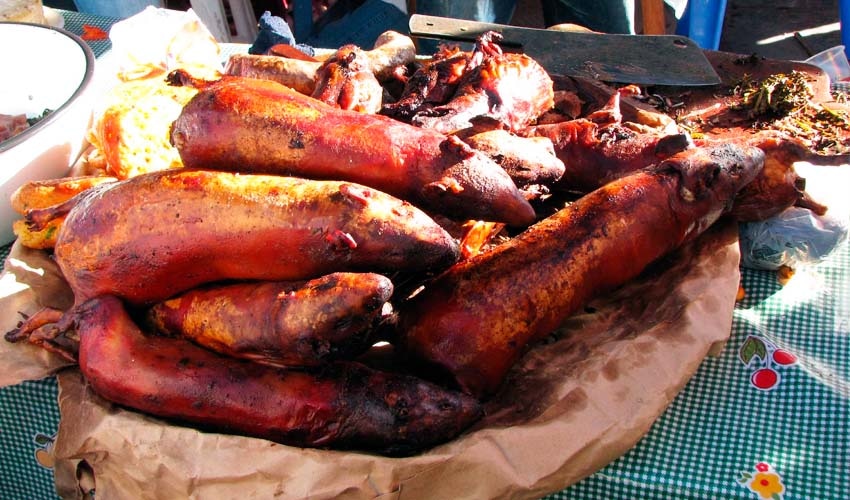
Cuy, also known as guinea pig, is a small rodent native to the Andean region of South America. It holds cultural significance in countries like Peru, Ecuador, Bolivia, and Colombia, where it has been consumed for thousands of years.
Cuy is primarily raised for its meat, which is considered a delicacy in Andean cuisine. It is rich in protein and low in fat, making it a valuable source of nutrition, especially in high-altitude regions where other protein sources may be scarce.
In Andean cuisine, cuy is prepared in various ways, including roasting, frying, grilling, or baking. It is often seasoned with herbs and spices, such as cumin, garlic, and ají (hot pepper), to enhance its flavor. The meat is typically served with accompaniments like potatoes, corn, and salad.
Cuy holds cultural significance beyond its culinary value. In indigenous Andean communities, it is associated with rituals, celebrations, and social gatherings. It is also believed to have medicinal properties and is sometimes used in traditional folk medicine practices.
While the idea of eating guinea pigs may seem unusual to some, it is an integral part of Andean culture and cuisine, offering a unique culinary experience for adventurous travelers and food enthusiasts visiting the region.
A ‘Cuyeria’ is a restaurant that serves Cuy, and if you want this food from a menu, that’s the sign you need to look for.
‘Guinea pig is also street food’…. get a pile of Cuy in a basket. Enjoy at anytime of the day, for breakfast, midday snack or a filling plate at lunch or dinner.
Visit San Pedro Market for either cooked and raw cuy. Once there, take your time and explore this vibrant market with authentic Andean textiles. This market pretty much sells everything, from local herbs and spices, fruits and vegetables, food stalls and a wide selection of possible souvenirs to take home with you.
There are many people selling guinea pigs here, and we finally pick out a vendor with some deliciously minty-smelling guinea pigs. We trust our friend Saul to select for us the best one.
The price we agree upon for one medium-large pig is 50 Nuevo Soles (about US$15), and that should already indicate to you that this isn’t just a fast food meal in Cusco.
This lady selling cuy didn’t want many photos, but when noticing that we were obviously not just in it for the Instagram opportunities, she was very happy to share details, and show off her decent selection.
Her take away bag includes a few yellow skin potatoes (adding peppers from the woman selling next to her for another 2 Soles), and we happily take our meal around the nearest corner.
We are quickly searching for a place to sit down, eager to enjoy Round 1 of cuy for today.
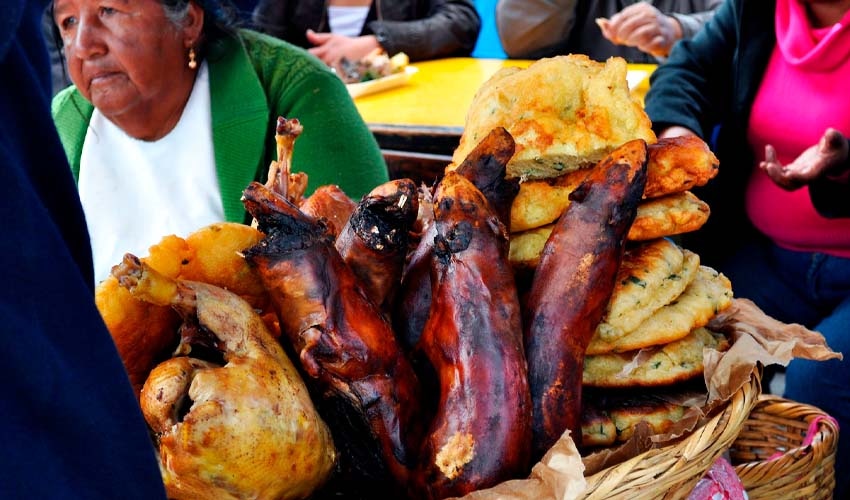
This cuy is pre-grilled, stuffed with ‘huacatay’ mint, and encased in an gloriously unspeakable amount of crinkly, reddish-brown crispy skin. Bubbling up and blistering on the side that’s closest to the fire, the skin is brittle, like thin, oiled pork skin, but does not smell like pork at all. Infusing into it along with so much smoky flavor too is the almost licorice tasting Peruvian black mint.
Layers of Diverse Texture
Inside the cuy, incredibly its not like pork either – I can only think of something super juicy and rich like quail – its obvious that this is not your average fattened farm-meat flavor. Finally, getting into the parts slightly farther from the belly, the skin is more chewy, and you have to really pull hard to rip off pieces.
The best way to eat is with your hands, and you may also get funny looks for eating it any other way.
Go for the skin first, and then you can then dig into the upper layers of meat. Its great to eat just taking your time, moving through incredible textures, until you reach the final and softest layers all the way down inside.
The amount of meat is actually surprising, and you can really be full having one entire cuy all to yourself. This meat is quite rich though, so take time and savor each bite, there are so many different exquisite parts to find.
Our friend says that the the neck, the hands, and the innards like heart or kidney, are more tasty than the ‘normal’ parts of cooked cuy, and at home, these are the parts people fight for!
Cusco is the tourism capital and walking tours of the city are an absolute must. Enjoy the cobbled stones street, and architecture that’s an eclectic mix of Spanish and Inca culture and the vibrant street markets.
These are some of the must-try only in Peru specialties.
You can find many vendors around Cusco making this delicious tea using a massive amount of herbs, as well as vegetables. Sugar and a squeeze of lime juice are added before you can enjoy this tasty, yet nutritious drink.
(One large cup is usually 1 Nuevo Sole)
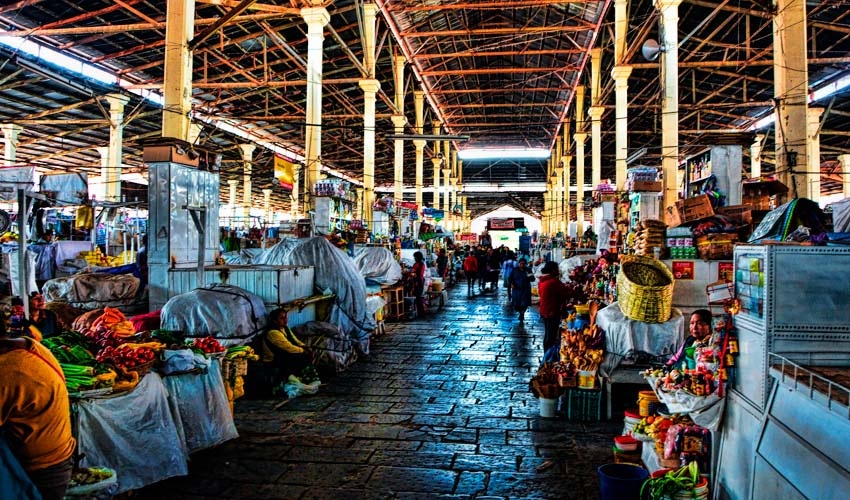
The best estimate I see online says that Peru eats 60-65 million guinea pigs each year, just slightly less than the estimate for guinea pigs people keep in the USA as pets.
Fun numbers to compare, but the fact is that guinea pigs are a better farming choice in many ways over larger animals. Most importantly, they take up much less land area (the creation of grazing lands for livestock being the leading cause of rainforest deforestation). Additionally, guinea pigs eat a lot less.
Locals believe that the meat of cuy can aid in curing many ailments that weaken the body. Peruvians find guinea pig to be healthier than the average farm poultry or red meat.
These are local beliefs that have been passed down from one generation to the next. There is a profound love and respect for guinea pigs in Peru and is a significant part of their customs and traditions.
Tipon deserves a special mention when talking about Cuy. The streets of this small village town are always lined with roasted cuy and it’s the best short-trip destination to try cuy the local way. Located only a few miles from Cusco and easily accessible by taxi or local transport, this is a great option for a lunch or dinner outing. It is unmistakable to see why this town is famous, as even the statue welcoming you to the town’s central intersection is a Peruvian woman in traditional dress, serving up a larger-than-life-size plate of cuy.
There are plenty of restaurants to choose from in Tipón. But look for one that uses a clay oven, making “Cuy al Horno” the traditional way or roasting them on an open fire.
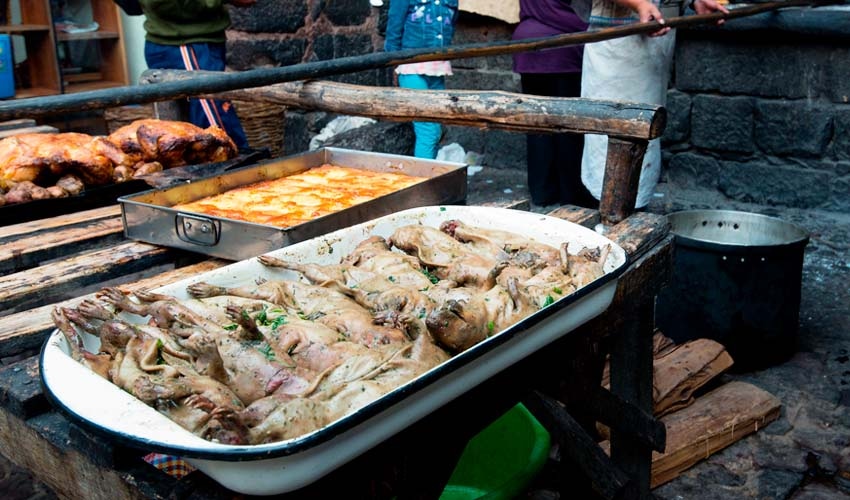
Adobe mud bricks make the oven, as well as some heat-resisting porcelain tiles that make it easier to slide food in and out.
Covering the outside of the oven with smooth clay helps keeps the heat in of course, but also the shape of the oven is special – it cooks the meat differently than it would just using the same wood under a grill.
Heat is coming more evenly from all sides, and the chef can just rotate a dish or (with the spaghetti) give it a few stirs, to make sure that no single side gets too much heat before its done.
Arriving right around the chef’s and owner’s own lunchtime, there are a few minutes to catch our breathe, and snack on some massive choclo corn kernels.
Peru is home to corn by the way, and although you can enjoy an incredible amount of corn in Lima, (on a street food tour), the size and variety of corn in Cusco will absolutely blow your mind.
This plate may have the largest single kernels of corn I think I’ve ever seen, and there’s so much moisture inside each one that they actually gush with milky flavor as soon as you bite into them.
By the way, I want to include vegans and vegetarians in this post as well – its not only the corn, also the potatoes here are amazing (probably the world’s best french fries), there are plenty of amazing meals in Peru that don’t have any meat at all.
The chefs are ready, and the fire is hot. Smoke pours out of a chimney on top, directing it out to lure in other hungry customers.
(and it works too, a large delivery truck immediately pulls up to grab several plates of cuy to-go)
She cooks all the food she serves here right, all inside the same clay oven in front.
We order a full meal, which at Cuyeria Mónica means a lot of other local additions to go along with our cuy.
There’s pasta today, which she parboils in hot water before she transfers it to a tray. She mixes in eggs and butter (mantequillia), before putting sliding it into the clay oven to finish cooking.
She stirs it occasionally so that it cooks evenly, not overly hard on top, and together with the cuy it makes this second breakfast quite a feast for sure.
The pasta is still quite chewy, as it just cooks in the dry heat for a few minutes, and is yet one more example of a ‘simple’ food that I never thought I would enjoy so much here in Peru!
She also serves potatoes (papa), and they’re full of smoky flavor as well.
You will absolutely love the texture of the potatoes here, and I’m not kidding – sometimes you can even just scoop the skins out with a spoon the inside flesh is so creamy.
Then finally there’s the pepper… not a meal of its own, but it is so delicious that you can’t possibly refuse.
Honestly though, no meal of cuy will be complete if it doesn’t come with at least one beautiful red or green local Rocoto (flaming hot)* pepper.
Rocoto rellenos are an amazing food on their own, and here at Cuyeria Mónica they come with an incredible amount of ingredients inside.
*I’m even still day-dreaming of Cusco’s Rocoto chili fire right now.
Cooking in that clay oven, there’s enough heat to grill the pepper’s outer edges, while inside it will still be soft and creamy. If there is enough cheese inside, you will see a wonderful volcano effect with glorious amounts of white cheese just bursting out the sides of your pepper.
Each bite of the rocoto as a whole has a flavor profile that just leaves you in happy amazement, and adding that with a nip from a raw rocoto as well, makes sure to light a fire in the mouth as well!*
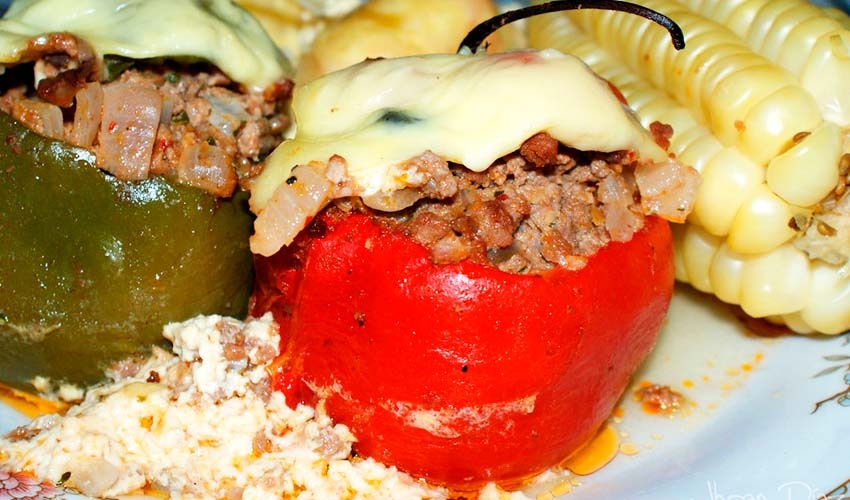
In the pepper comes sweet carrots, peas, cloves, cinnamon, mint, and as the top is sliced off, a chunk of cheese is the final ingredient, and the pepper top is put back on.
This has the potential to be one of the spiciest foods in all Peru, but actually the way they prepare the chili can vary greatly.
Most of the time, they will remove all the seeds from these medium-length, fat Rocoto chili peppers. After this, they even soak the pepper flesh for 1-2 more days to lessen the heat.
After this, only then does the chef stuff the pepper, and then cook it – either roasting on a small grill, or traditionally, in an earthen oven, like at Cuyeria Monica – and even then it can still be slightly spicy.
These peppers are no joke, but they’re easily some of the most delicious and flavorful peppers on earth.
*For real chili lovers, make sure to try a fresh rocoto. You might have to ask for it specially, because most people don’t eat them raw, but I would say this is easily one of the most deliciously hot peppers that I’ve ever eaten. Experiencing them several times in Cusco, always tearful, red in the face, and widely-grinning with pure joy).
Moving between bites of the soft potato, thick pasta, and gorgeous balance of ingredients in the pepper, I still have to give it up to the flavor of Cuyeria Mónica’s roast cuy.
The hind legs and back are especially sensational, I am just in awe of the depth of flavor that cuy meat can contain.
You can see the amount of Peruvian black that chefs will stuff into the cuy’s body cavity before it cooks.
It’s hard to describe how this infuses literally every single bite with its flavor. With so much filling inside, the flavor even penetrates and works its way while cooking, all the way to the outer-most layers of skin.
Not just minty-ness either, I can’t help but think of licorice – actually it reminds me of Thai sweet basil – the flavor is wonderfully rich, like no other single herb I know.
Last but not least, notice how the intestines are already gone. This is what creates the open space for all that mint in the first place.
Also useful themselves, and good to eat, but the traditional style is to remove the intestines, clean them, and use them in a separate dish (an example of which you will see at the next restaurant back in Cusco).
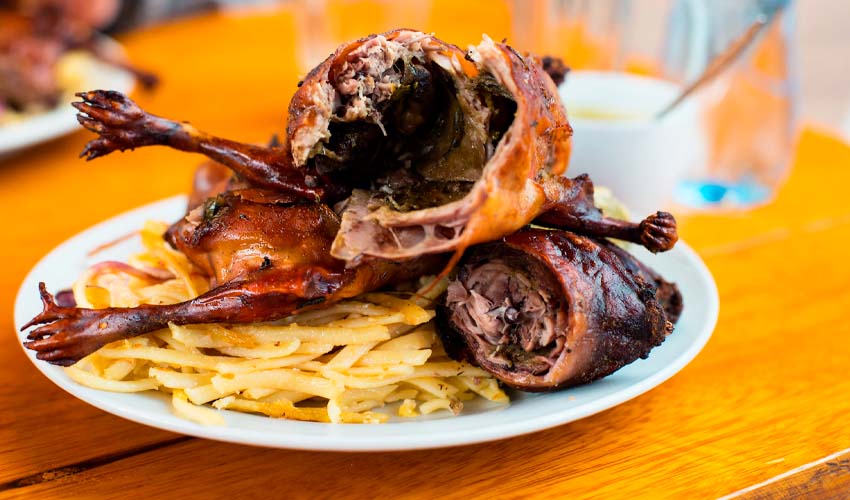
The total for everything today is 110 Nuevo Soles, or PEN (equals about US$32), and that price includes many drinks and another plate for take away.
During the drive back to Cusco, Junior tells us a few more stories he remembers of local information about cuy. Learning from him, and doing some fact-checking online, there are still a few more interesting things I want to share with you.
In the past, Cuy would live their lives both inside and outside of a family’s home. An average Cusco farming family usually takes care of about 50-60 cuy.
In the warm weather of summer, the cuy would fatten, reproduce, and spend more time outside. During the cold months, they live mostly in the kitchen, keeping warm.
Peruvian cuisine includes a lot of delicious potatoes, the shavings of which can add up quickly. The cuy keeps food waste to a minimum. It eats the scraps and other leftovers.

On arrival at Cuyeria Sol Moqueguano, you can almost be certain that there will be a line reaching down to the front steps.
Rest assured this restaurant serves about 1,000 guinea pigs a day, maybe even more and no one leaves hungry.
Guinea pig is already quite rich, so whoever first thought to deep-fry an entire cuy… I simple have to applaud and congratulate their genius.
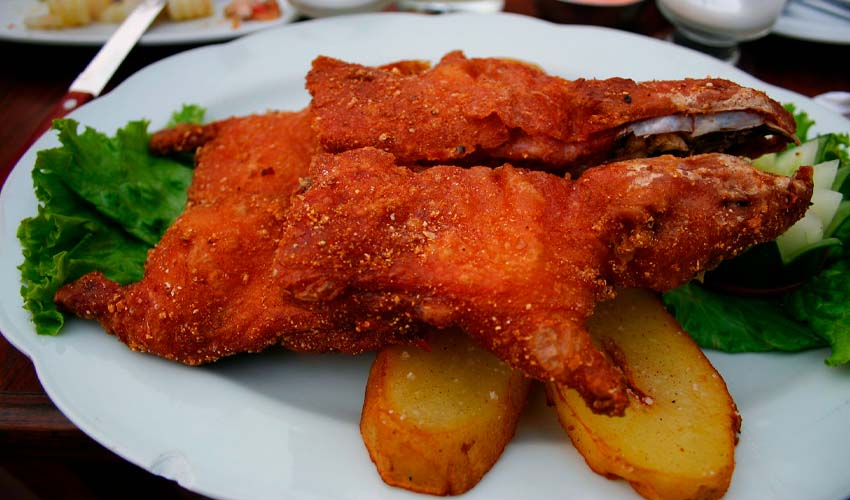
The order you’ll see on most tables here is a half-order of cuy, which they serve with potatoes, aji green chili sauce, and a rocoto rellenos chili pepper.
Many people though, are going for the full plate of cuy chactado, and this is what I also have to recommend to you today.
Suddenly it is obvious there how there is something missing from the other meals of cuy today – the aji chili dipping sauce!
It really comes with the potatoes, but it tastes great on absolutely everything. Maybe we just forgot to ask earlier, but this restaurant just serves everything to you from the beginning.
Don’t miss the dipping sauce, and if you can find yet another fresh rocoto chili to add to it, you’re in a great place indeed.
It has come down to the last bite of the day, the Cuy Sausage!
No matter how full you are, this item is still so delicious, I have to take a few more lines to describe some truly incredible texture genius.
Without looking, its almost as if there are chunks of french fries inside, amidst bits of oily cheese – and sour slightly sour at that.
A key part to any great sausage is texture balance, and this cuy sausage is outstanding.
Its obvious that there is also a large amount of blood in this recipe, and I wonder if the sourness is from slightly-fermenting ‘moraya’ potatoes as well.
The sausage is amazing, and I am glad we got to try it to end this amazing day in Cusco.
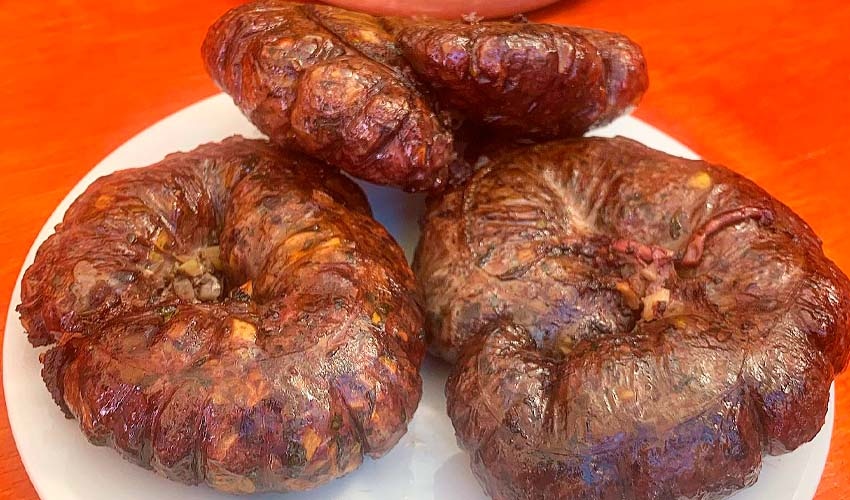
No matter if you share one, two, or five guinea pigs in a single day (and our consensus is down below), the differences between restaurants and styles are still noticeably clear.
There are a few recipes for this food around Cusco, but there are also a huge variety of different atmospheres and styles in which you can enjoy the tradition of cooking cuy as well.
Besides the great flavor, and uniqueness of a new and amazing food, it was also just a great experience overall today – thank you Peru, thank you to our wonderful friend Junior, and thank you to each of the amazing chefs, sharing with us their own takes on this amazing dish of ‘Cuy.’
On the whole, I can’t say that any of these meals was better than any other, as atmosphere really does affect the outcome of a superb meal. All 3 Cuy experiences today will be so different, there’s no point to compare…
However – in terms of pure flavor, its no comparison – Cuyeria Sol Moqueguano is THE Place.
If you’re looking for only one Cuy guinea pig today, this is your spot. Make it easy on yourself, and come early – don’t wait for a timely late lunch today, this place is likely to be packed before noon.
It is immediately obvious arriving at Sol Moqueguano that this is the restaurant where local people love eating Cuy with the entire family.
Tipón is obviously the cultural center when it comes to the tradition of cooking Guinea Pig – If you’re looking to experience the full history of this amazing food of ancient Peru, then Tipón is the place.
Just a 40-minute drive, a beautiful drive too, this is authentic and traditional country side cooking, and a great experience (its also just amazing to arrive in Tipón and have your welcome be a larger-than-life statue of a chef serving roast Cuy).
In the downtown Cusco streets though, the large city inevitably draws in a few great examples of food from all the surrounding countryside areas, just like any metro area in the world would.
There are many restaurants serving Cuy al Horno or Guinea Pig in the city streets as well,
While I personally will advise you that 3 in one day is probably the correct number, our final consensus is…
You absolutely cannot visit Cusco without having at least one entire Cuy guinea pig, all to yourself.
Thanks for reading, see you for the next article!